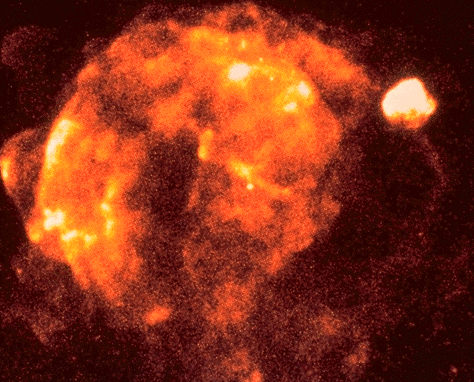Explanation: What happens when a star explodes? A huge fireball of hot gas shoots out in all directions. When this gas slams into the existing interstellar medium, it heats up so much it glows in X-rays. The above picture by the ROSAT satellite has captured some of these X-rays and shown -- for the first time -- the Vela supernova explosion was roughly spherical. Non-uniformity of the interstellar medium causes Vela's appearance to be irregular. The size of this X-ray emitting spherical shell is immense - 230 light years across, covering over 100 times the sky-area of the full Moon. The supernova that created this nebula occurred about 1500 light years away and about 11,000 years ago. Coincidently, a completely different supernova shell can also be seen in X-rays in this picture! It is visible as the bright patch near the upper right. This Puppis supernova remnant nebula is actually about four times further than the Vela nebula.
1999 2000 2001 2002 2003 2004 2005 2006 2007 2008 2009 2010 2011 2012 2013 2014 2015 2016 2017 2018 2019 2020 2021 2022 2023 2024 2025 |
Январь Февраль Март Апрель Май Июнь Июль Август Сентябрь Октябрь Ноябрь Декабрь |
NASA Web Site Statements, Warnings, and Disclaimers
NASA Official: Jay Norris. Specific rights apply.
A service of: LHEA at NASA / GSFC
& Michigan Tech. U.
|
Публикации с ключевыми словами:
Vela - supernova remnant - supernova - Сверхновые - остаток Сверхновой - рентгеновские лучи
Публикации со словами: Vela - supernova remnant - supernova - Сверхновые - остаток Сверхновой - рентгеновские лучи | |
См. также:
Все публикации на ту же тему >> | |
